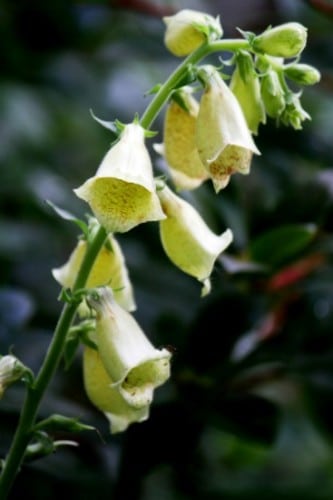You might have noticed some perennials seemed to move too rapidly through their growing and flowering cycles this summer. That was their response to the extreme and prolonged heat, lasting for approximately eight weeks, and forcing plants to set seed and shut down to preserve their energies. But with the return of cool nights and reliable moisture, some perennials have returned to offer a few unexpected blooms. While cleaning the front bed, I discovered two lovely foxgloves with new flowers.

The straw foxglove (Digitalis grandiflora, Zone 3, sometimes known as D. ambigua) is a charming, meadow-like plant that can develop a thick and long-blooming clump that’s reliably perennial. Its pointy wands of pale yellow bells (with brown netting in the throats) grow two to three feet (60 to 90 cm) tall, somewhat shorter than other foxgloves and pleasing in every way. I also found some flowers of D. purpurea ‘Camelot Rose’, reminding me how gorgeous these D. purpurea hybrids can be, and I must get more. Their thick rosettes of foliage are low and make a good groundcover. They grow in partial shade to full sun, providing the soil is kept consistently moist. D. purpurea and its hybrids are often biennial plants, but sometimes will change to perennial behaviour if happy in their circumstances. And when conditions are ideal (organic soil, consistent moisture and moderate temperatures), one can hope for self-sown seedlings.
Other posts by Judith this week:
Posts from Judith last week:

Hi Clare,
Keep everything! Yes, you can transplant the seedlings, and if they’re of reasonable size, possibly will have flowers next spring. One trick is to use a transplant solution with rooting hormone, and that will help them to make root growth before the ground freezes, and they’ll be more mature next spring. At a garden centre, look for liquid concentrate transplant solution with indole-butyric acid. Also, keep the plants that bloomed this year, they may be happy in their location and possibly turn perennial, if only for one more year. But if they’re dead in spring, that’s it for them!
— Judith
Can I transplant the self-sown seedlings and hope for flowers next year? Should I dig up and compost the ones that bloomed this year? The green leaves look healthy and verdent. Thanks!
Hello Lynne (October 12),
Thanks for the reference to diseases of spruce and pine, and the symptomatic needlecast they cause. Conifers drop needles in different seasons and for different reasons. Needlecast of older foliage (from the interior of the plant) in autumn is a natural and healthy process. Needlecast of first-year foliage (from tips and young wood) in late winter and early spring is associated with disease pathogens (Rhizosphaera on spruce, and Lophoderium on pine), and the needles are disfigured with yellow and reddish brown spots, an obvious display of disease.
The general term needlecast simply refers to conifers dropping foliage. It’s best to avoid confusion by naming possible diseases specifically. What we see in October are clean, unmarked older needles being dropped. And isn’t that a relief!